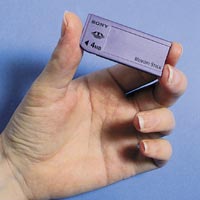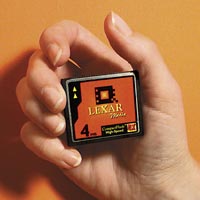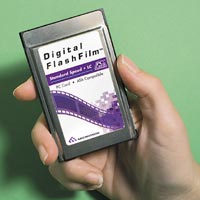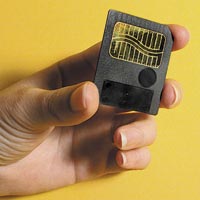Where does the light when you turn off a light bulb? If we reject the philosophy, the answer is: no matter where he was going away, it simply does not exist anymore. The same can be said about most types of memory: when the power of its content is lost. Although it was previously necessary non-volatile memory retains its contents without power, is now a need to increase as people's desire to invent a more simple ways to store and transmit information between computers, hand-held "electronic secretaries, digital cameras and multimedia devices. New technologies allow us to make such a memory device smaller, lighter, high-speed and cheaper than ever before.
 |
All the new memory device based on technology CompactFlash, DataFlash, SmartMedia and Memory Stick from Sony is based on Rom. If memory (RAM) - a random-access memory, the ROM (ROM) - read-only memory. The title reflects one of its properties - you can not change the stored information in it. Another important feature that distinguishes ROM from RAM, is that in order to save the contents of ROM does not require power. In memory storage elements which serve to store, consume a small current to maintain its state (enabled or disabled), and ROM status of these elements is fixed and can not be changed. That's why sometimes called ROM indelible nonvolatile memory: its content remains unchanged when the power is off. Initially, the information in the ROM should have been "written" directly on the chip in the manufacturing process for application of the masking layer, becoming its constant part, as well as in CD-ROM CD-ROM. This technology requires a fairly high cost, and in addition, such information can not be replaced, even a slight change of data stored on the chip was leaving a lot of time and money.
 |
A more flexible approach was implemented with the creation of programmable ROM (PROM - PROM), similar to CD write-once (CD-R). In the manufacture of these chips require more voltage for writing data than recording them in memory. At higher voltages the data are burned in different areas of memory on the chip. Recorded data thus can not be changed, but the process of making crystals with different contents is fairly simple. Then came the turn of erasable (programmable) EPROM (erasable read-only memory - EPROM), similar to CD-RW discs (CD-WR). It already has the ability to record information in memory, but if you want to make changes, will erase all data on the crystal and repeat the recording process again. The next important step was the creation of electrically erasable programmable read-only memory (EEPROM - EEPROM), working like a PROM, but have a major advantage: erasing the information in it is simple supply signal with a higher (compared to normal) stress. The result is a ROM whose contents can be changed directly in the process. It is used to store various data on the programs BIOS (Basic Input / Output System) settings to configure the printer.
A gift of fate?
All this brings us to the currently applicable in the flash memory (sometimes called flash ROM or flash RAM). Flash memory on a plan remains very close to the EEPROM, but it has one key advantage: for it does not require a higher voltage than is used in computers or digital cameras (usually from 3 to 5).
 |
As with all ROM erasure of information in the flash memory cycles write / erase limited. In the early models of these devices allow the execution of only a few tens of thousands of write cycles, but some new developments are suitable for execution of millions of cycles or more. Flash memory has become the main type of memory for the BIOS, used in computers and modems, because it makes it very easy to perform upgrades of these devices. You simply download the file from the Web-site of the manufacturer, and then run a utility that erases the previous contents of memory, and makes it new information. You can also perform writing and erasing information only on selected sections of the crystal, so that some of this memory can be protected, while others undergo changes. This provides the opportunity to reboot the system if in the process of modification of mistakes were made.
 |
These features of flash memory make it extremely attractive for applications in portable equipment such as hand-held "electronic secretary" and digital cameras, in which users would like to change some of the data, leaving the rest unchanged. Some portable devices as a replacement set of memory standard 3.5-inch floppy disk, but it is a mechanical device memory is large, with limited capacity, and consumption of energy is quite large (which reduces battery life). For comparison: the device Memory Stick from Sony has a high speed, consumes significantly less power and can store up to 32 megabytes of information (more than 20 floppy disks). There is another approach in which a miniature hard drive is placed in the housing PC Card (PCMCIA). Although this method allows you to store large amounts of data (from 500 MB to 1 GB) at a lower cost per 1 MB, it requires a slot Type III (the equivalent of two jacks Type II) and in an active state is a memory device consumes approximately ten times more power than flash memory. Flash memory has several advantages compared to these mechanical magnetic storage devices. It can be manufactured in much smaller volume of the shell and consumes much less power. In addition, in this semiconductor memory no moving parts that can be easily damaged. This design makes the flash memory more resistant to possible careless handling when working with portable devices. Board flash memory can serve as a removable storage media for portable devices. However, a more difficult problem is data transfer to a regular computer. A common solution to this problem is to create a reader PC Card, who is connected to the input board flash memory, and output connector is inserted into a standard slot PC Card Type II. For desktop computers without PC Card slots, there are readers that connect to parallel, SCSI-and USB-port. Some readers even allow you to use memory cards of different formats. The disadvantage is the lack of a unified standard for the implementation of flash memory for portable devices. If you have two portable devices, then they can use cards of different types. Several different designs boards currently competing for the right to become the standard. DataFlash. This method involves placing a flash memory card PC Card Type II, which facilitates the exchange of information between any devices with connectors Type II. To simplify the use of such memory cards for desktop computers, they perceived the system as a standard hard disk drive IDE.However, compared to the small size of many digital cameras and handheld devices the PC Card still quite large. Therefore, DataFlash cards are generally used in large professional digital cameras, where their size does not play a big role. SmartMedia. This fee is a small format, also known as the SSFDC (Solid State Floppy Disk Card, board semiconductor floppy disk), has a size of about 43x38 mm - less than half the usual business card - and the thickness of wafers, ie, only 0.77 mm . For cards in this format, there are several different adapters, including the adapter PC Card, installed in the slot PC Card. You can also use the floppy disk adapter for SmartMedia, allowing the computer to read data from the device to read from a floppy disk in the absence of slots PC Card. CompactFlash. These boards have about the same size as SmartMedia, but they are slightly thicker, about 3.3 mm. This is partly explained by the fact that they are circuits of the memory controller with a standard interface IDE. As a result, manufacturing cost rises, and with less memory, CompactFlash card is more expensive than SmartMedia. However, when the amount of memory of 16 MB and above the cost of these two cards is roughly the same. Because the CompactFlash card contains its own controller, the costs of making readers and adapters are much lower than that reflected in market prices. Thus, the PC Card adapter for SmartMedia usually costs about $ 80, and the price of an adapter for CompactFlash card is only $ 15 Memory Stick. This new device developed by Sony. With dimensions of 21,6 x50, 8 mm and a thickness of 2.8 mm, it looks like a small plate of chewing gum. For boards such format from Sony releases the adapter PC Card, and an adapter that plugs into the parallel port. Indelible-volatile memory has come a long way from the BIOS ROM chip for the first computer company IBM. Advantages of advanced flash memory, allowing both read and write, not limited by the fact that a surprisingly small and rugged, you can put a lot of megabytes of data. In addition, it allows you to quickly and easily transfer large amounts of information between different devices.
| Types of Flash Memory | | Format | Size |
|



